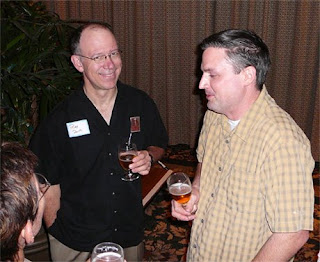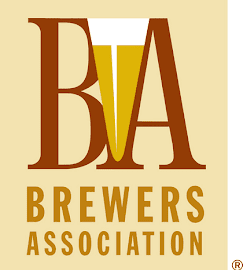 Today at noon ―Munich, Germany, time― the lord mayor of München tapped the first keg of the Oktoberfest. Standing in the Spaten (Schottenhamel) tent, he proclaimed "O'zapft is!" ("the barrel has been tapped").
Today at noon ―Munich, Germany, time― the lord mayor of München tapped the first keg of the Oktoberfest. Standing in the Spaten (Schottenhamel) tent, he proclaimed "O'zapft is!" ("the barrel has been tapped").
Oktoberfest continues through 5 October.
A brief history of lager and Oktoberfest beer
The genetic identity of lager yeast has only just recently been mapped. Two distinct strains have been identified, each containing genetic material and consequent traits ―including tolerance for cold― from other yeast strains.
[Read more about Saccharomyces pastorianus at The Zythophile.]In 1841, brewers Anton Dreher in Vienna and ―friend and rival― Gabriel Sedlmayer in Munich began brewing with at least one of these lager yeast strains.
A year later, lager yeast was introduced into breweries in Pilsen. The low pH and low mineral content of that city's water allowed the brewing of hoppy, crisp, and lighter-hued lagers ―known as Pilsners, literally, "from Pilsen."
[Historian and brewer Rich Wagner believes that the first lager brewery in the US opened in 1840 in Philadelphia, thus trumping Vienna, Munich, and Pilsen.]Attempts in Munich and Vienna to brew similar Pilsen-style lagers were unsuccessful.

In Munich, Sedlmayer soon empirically grasped that it was his city's highly alkaline water that was producing harshness when mashed with lighter malts. He switched to darker malts ―of higher acidity― and had much more palatable results.
Vienna's water was also alkaline, but less so than that of Munich. Thus, Dreher was able to successfully brew his lagers with less-kilned amber malts. His Vienna lagers were darker than Pilsen's but lighter than Munich's.
Both brewers continued to upgrade their breweries and processes, especially in areas of barley agriculture and malting technology. In lieu of refrigeration, they collaborated in pioneering the commercial application of beer storage in cold caves and cold cellars. This became known as the märzen process ―literally "from March"― because the beers would be made in the cooler months, and then cold stored during the summer.
In 1860, both Dreher and Sedlmayer installed a new technology called ... refrigeration.
The beer poured during the first years of Oktoberfest was the dark Munich style. It wasn't until 1872, with better understanding of water chemistry, that the brewmaster of the Spaten brewery ―Josef Sedylmayr (younger brother of Gabriel)― was able to introduce the brewery's amber-hued Märzen as
the Oktoberfest bier. Based on brewing records, it would have have been medium-bodied, tasting of softly toasted malt, and with possibly just a nuance of yeasty tooty-fruity. The other Munich breweries would soon follow suit.
These amber lagers produced in both Vienna and Munich and associated breweries rivaled the popularity of the lighter-shaded Pilsner lagers.
Oktoberfest style: then and now.
The beer served at modern Oktoberfests is
not this rich amber lager. It is a much less robust beer: lighter in color, body, and flavor. Fortunately, there are indeed many other breweries that still produce '
1872-style' Oktoberfests ―but just not in Munich.
Here's how the U.S.
Beer Judge Certification Program (BJCP) describes the Oktoberfest-style:
- Aroma
Rich German malt aroma (of Vienna and/or Munich malt). A light to moderate toasted malt aroma is often present. Clean lager aroma with no fruity esters or diacetyl. No hop aroma. Caramel aroma is inappropriate.
- Appearance
Dark gold to deep orange-red color. Bright clarity, with solid, off-white, foam stand.
- Flavor
Initial malty sweetness, but finish is moderately dry. Distinctive and complex maltiness often includes a toasted aspect. Hop bitterness is moderate, and noble hop flavor is low to none. Balance is toward malt, though the finish is not sweet. Noticeable caramel or roasted flavors are inappropriate. Clean lager character with no diacetyl or fruity esters.
- Mouthfeel
Medium body, with a creamy texture and medium carbonation. Smooth. Fully fermented, without a cloying finish.
- Overall Impression
Smooth, clean, and rather rich, with a depth of malt character. This is one of the classic malty styles, with a maltiness that is often described as soft, complex, and elegant but never cloying.
- Comments
Domestic German versions tend to be golden, like a strong Pils-dominated Helles. Export German versions are typically orange-amber in color, and have a distinctive toasty malt character. German beer tax law limits the OG of the style at 14 °P since it is a vollbier, although American versions can be stronger. “Fest” type beers are special occasion beers that are usually stronger than their everyday counterparts.
- History
Origin is credited to Gabriel Sedlmayr, based on an adaptation of the Vienna style developed by Anton Dreher around 1840, shortly after lager yeast was first isolated. Typically brewed in the spring, signaling the end of the traditional brewing season and stored in cold caves or cellars during the warm summer months. Served in autumn amidst traditional celebrations.
- Ingredients
Grist varies, although German Vienna malt is often the backbone of the grain bill, with some Munich malt, Pils malt, and possibly some crystal malt. All malt should derive from the finest quality two-row barley. Continental hops, especially noble varieties, are most authentic. Somewhat alkaline water (up to 300 PPM), with significant carbonate content is welcome. A decoction mash can help develop the rich malt profile.
[Read here and here about two of my personal favorites.]
How the Einsteins brought refrigeration to Oktoberfest
For the first 74 years of Oktoberfest, it was ice or simple cellar storage that would keep the beer cool. And it was gas or candle power that would illuminate the
festival wiesen (meadow).
Then, in 1885, electrical power finally came to Munich's Oktoberfest, wired and generated by ... the
Einstein Bros. Company.
Yes,
that Einstein!

Albert Einstein was only 6 at the time, but in the following 9 years, he would work at his uncle and father's electrical engineering firm. In his teens, he helped to design several mechanical innovations.
In 1894, Munich removed the contract from the company and awarded it to
Siemens. Yes,
that Siemens. Einstein Bros. was bankrupted.
Albert Einstein would move on to more theoretical pursuits. But it was Einstein's father Hermann, and his uncle Jakob, who first gave the world a cold beer at Oktoberfest. And
that's a noble achievement.
Toast them over the next 3 weeks with a Vienna-style lager, or a Märzen, or an Oktoberfest ―all variations on the same delicious theme.
Prosit!
-----more-----









.png)






